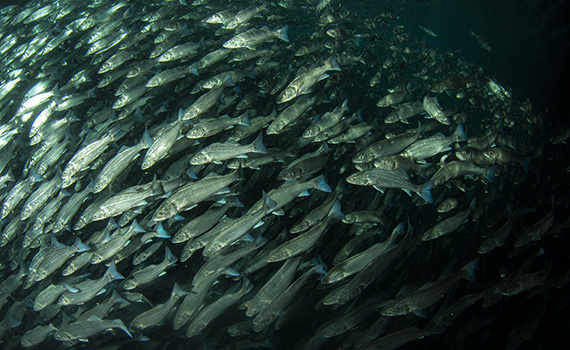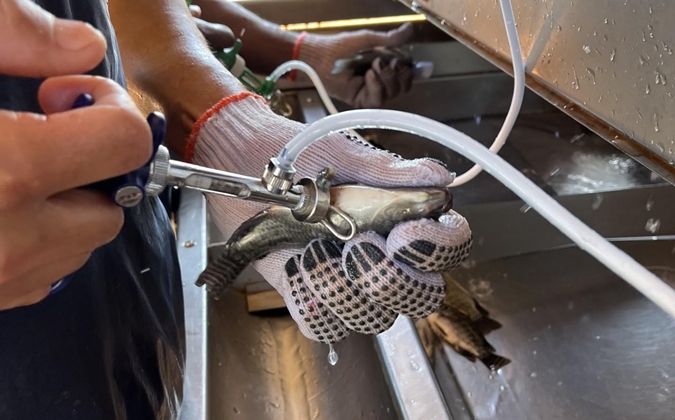
Fish Farm Forum is pleased to host this editorial page on behalf of Pharmaq.
Pharmaq
Safety and welfare concerns drive shift to licensed anesthetic in Mediterranean aquaculture
This article includes information about authorized veterinary medicines and is intended for professional fish health personnel only.
Interview with Roberto Guijarro, DVM, PHARMAQ Business Unit Lead, Southern Europe
Q: Anesthesia plays an important role in aquaculture processes such as fish vaccination and sampling. Tricaine PHARMAQ® (tricaine methane sulphonate) is currently the only anesthetic licensed for use in Mediterranean aquaculture, but its use has been limited until recently. What’s driven the increase in use over the last few years?
RG: Sea bass and bream producers in the Mediterranean region have historically tended to use lower-cost chemicals which are not officially approved for use in aquaculture. In the last few years, however, producers have come under increased pressure from authorities and especially certification labels like Global Good Agricultural Practices (GAP) to use licensed products with a proven safety profile. Food safety, animal welfare and public perception are also concerns: If a negative story comes out, it may affect not just one producer but possibly the entire industry. Together, these factors have driven a significant uptick in the use of Tricaine.
Q: What are the advantages of opting for the licensed product?

Roberto Guijarro, DVM
RG: Aside from fulfilling legal requirements, a major consideration is safety. It’s very easy to damage such a delicate animal during anesthesia, and producers are very concerned about this during vaccination, as well the post-anesthesia stage when you are releasing fish back into cages.
Tricaine has an excellent safety profile: It is possible to adjust the dose to safely take fish to a deep state of anesthesia with a very low risk of mortality. This is not the case for a product like clove oil, which can kill fish outside a narrow range of concentration. You can also use it at high doses with confidence in high-value fish, such as the brood stock.
Another benefit of Tricaine is it has high solubility without requiring additional solvents. This is not the case for unapproved products, which require solvents such as acetone. This high solubility results in a really quick process of anesthesia, which minimizes stress to fish.
Q: How does a rapid onset of anesthesia help reduce stress to fish?
RG: The faster that fish can be taken down to a deep state of anesthesia, the less likely they are to damage each other, which is particularly important for species such as sea bass that have sharp dorsal fin rays. If the fish are held in a deep state of anesthesia they will be totally immobilized, so easier to handle and vaccinate accurately.
Tricaine is associated with not only a rapid onset of anesthesia but also a quick recovery. This is also beneficial for fish welfare as the fish can quickly be swimming around after the procedure, getting water moving across their gills. No other anesthetic offers famers and fish health professionals this degree of precision and safety, so I think this is also why we are seeing increased use as more people see these benefits of using Tricaine.
Q: How does Tricaine work?
RG: Tricaine is added directly to the water fish are accustomed to, due to its good solubility. It acts directly on the central nervous system, cardiovascular system, neuromuscular junctions and ganglion synapse, blocking communication between the brain and peripheral nerves and so eliminating sensory input. Loss of reflexes happens 1 to 15 minutes after immersion, depending on the concentration used.
Q: Does a veterinarian need to be present when Tricaine is used?
RG: It depends on the marketing authorization in the region. For example, in Spain, Tricaine is used by producers once they have been properly trained. In Italy, however, a veterinarian does have to be present due to the special status of Tricaine as a narcotic. It’s not a safety issue, as producers get on fine with the product on their own —more a legal matter.
Q: Other than vaccination, are there any of the other uses of anesthetic that are contributing to an interest in Tricaine?
RG: There is an increase in use when sampling to perform biometrics on the fish, as well as grading. This all relates back to the safety of the product, in particular when anesthetizing small fish.
Q: What training is offered for producers looking to start using the product?
RG: We always recommend that producers notify us that they’re interested in using Tricaine. Then, we offer them training in the field on how to set the best dose depending on factors such as the fish size and water temperature. We also have lots of additional training materials which they can consult at any time.
Q: Is the shift toward use of licensed anesthetics happening industry-wide in Mediterranean sea bass and sea bream production, or only in certain segments?
RG: In general, uptake of Tricaine is being driven by larger producers, which tend to be certified by Global GAP and the Aquaculture Stewardship Council and have tighter standards in terms of the products they use. They know that using a reliable, proven anesthetic translates to better welfare, lower mortality and improved food safety. If not, there is not only a risk to their reputation but economic risk too. Small- and medium-sized producers are also showing greater interest, as growing their market ultimately requires taking a similar view in regard to safety and welfare.
Geography is another factor. In Italy, Spain and France, fish vaccination takes place mainly in inland facilities. That means that you can very easily control the use of Tricaine, and you don’t need to use big volumes of the product. There is now a more general trend to move toward such facilities for vaccination, and we are expecting that Tricaine use will increase as we see more of these new buildings.
Posted on: December 03, 2021







